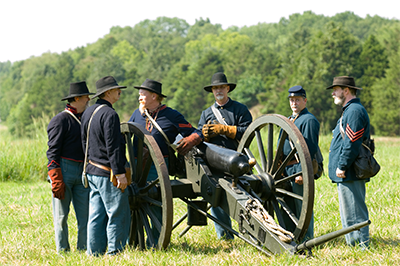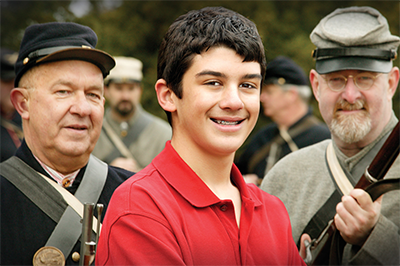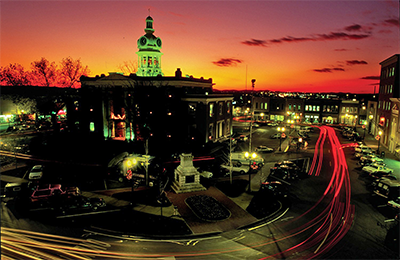MURFREESBOROUGH: A Town “Captured”
MURFREESBOROUGH: A Town “Captured”
By Shirley Farris Jones

Located in the exact geographic center of the state, bounded by rivers, a railroad, and productive farmland, war came to the people living in the quiet little town of Murfreesboro much sooner than any of her citizens ever could have imagined when the Confederate flag was hoisted above the Courthouse in the summer of 186l. Since the initial founding of Murfreesboro in 1811, the townspeople had enjoyed prosperity and a sense of well-being for half a century. Murfreesboro served as the capitol of Tennessee from 1819-1826 and was to host such well-known political figures as Andrew Jackson, Martin Van Buren, and James K. Polk. Businesses flourished, educational landmarks were established, and the quality of life was good. In 1860, following Lincoln’s election, the people first voted against secession but the firing on Fort Sumter and Lincoln’s call for troops changed things and a second vote resulted in an overwhelmingly victory for secession. With Tennessee’s vote to join the Confederacy on June 8, 1861, the citizens of Murfreesboro never dreamed that they would ever hear the roar of cannon, the rattle of musketry, or groans of the dying. Much less in their own back yard! Nor that the devastating financial losses incurred during enemy occupation would be theirs alone to bear.
Following the fall of Fort Donelson on February 16, 1862, and the evacuation of Nashville a few days later, Murfreesboro found herself under Federal occupation by early March. And with the exception of one brief reprieve, following Forrest’s Raid in July until the Battle of Stones River not quite six months later, would remain in Federal hands for the duration of the war. The so-called social highlight of the Confederacy, namely the wedding of Murfreesboro’s own lovely belle, Miss Mattie Ready, to the dashing, cavalryman from Kentucky, Brigadier General John Hunt Morgan, would quickly fade into history and the new Courthouse, only three years old, would find itself the target of a Federal cannon, aimed and ready to fire, in the event of Confederate intervention.
According to citizen John Cedric Spence, “On the tenth of March ... the ears of the citizens were greeted with the sound of drum and fife, the rattle of artillery wagons, columns of marching infantry, advancing with glittering bayonets, flags, insignia, and banners flying, prancing steeds, bearing riders with drawn swords, all pomp and display, headed by General Mitchell in advance. ... As the Federals took formal possession of the town, hoisting the U.S. flag in place of the Confederate flag on the Courthouse.”
The following months would be very difficult ones indeed for the people of Murfreesboro. General Mitchell began to question various citizens, followed by house searching, supposedly for the purpose of collecting guns and ammunition, and collections of law libraries, silver, family heirlooms, and valuables of every description went missing. Quite a change for the people who had heretofore never bothered to lock their doors. Many citizens were also arrested during this time and sent to prison, without being given any valid reason for their incarceration, other than being a “disloyal subject to the United States.” And businesses were not allowed to operate unless the owners had taken the oath and carried a pass, showing their compliance. Since many of the merchants had a son, brother, friend, or loved one fighting for the Confederacy and very few people were willing to submit, merchants closed out their stocks and refused to reopen. Everything was in scarce supply. Obviously, Murfreesboro was a Confederate town! Pressure was placed on the Mayor and Aldermen, the government officials of the city, to likewise take the Oath “for the sake of peace and interest of the public,” according to the Federal Provost Marshall, O.C. Rounds.
During this same time, General Mitchell desired a conference with Mayor John Dromgoole “on some business” and sent word asking where he could be found. The Mayor, being of a determined nature himself, understanding the implications, and wishing to evade the meeting, chose to go fishing instead. According to Spence’s account, “On leaving with fishing poles on his shoulder, remarking, if Gen. Mitchell wishes to see me more than I do him, he may come where I am fishing. I shall not go to him.”
From this day on, Murfreesboro was known as a “captured town.” In consequence, a town which is not surrendered to the Federal Army on their first appearance, and which is claimed to have been the duty of the Mayor at the time according to an act of Congress, shall be declared “captured” as a failure to comply with this requirement. Had a proper “surrender” been tendered, the town and citizens would be protected in person and property during the time of Federal occupation, citizens being allowed compensation for rents and damages sustained by the army. To date, Murfreesboro has yet to surrender!
And, in all probability, Mayor John Dromgoole had absolutely no inkling of the long-range ramifications his actions would have on the citizens of Murfreesboro when he picked up his fishing pole on that fateful spring day more than one hundred fifty years ago in 1862.
Reprinted with permission of the author, Shirley Farris Jones. Condensed by the author from Chapter l, THE UN-CIVIL WAR IN MIDDLE TENNESSEE, pp. 1-6, 2010.


Rutherford County is a vibrant, Southern community whose history is forever linked with the Civil War.
Stones River National Battlefield, located in Murfreesboro, commemorates the fierce Civil War battle that began on New Year’s Eve in 1862 and caused 23,000 casualties.
Oaklands Mansion is an antebellum home that was caught in the crossfire of the Civil War and was occupied by both Union and Confederate armies, and the Historic Sam Davis Home and Plantation in Smyrna was the boyhood home of a Confederate hero who was captured and executed at the age of 21.
For more Civil War history, visit the historic Rutherford County Courthouse, Fortress Rosecrans, the Hazen Brigade Monument, and the chilling Confederate Circle at Evergreen Cemetery.
Rutherford County also features Cannonsburgh Village, the Discovery Center children’s museum, Boro Beach Water Park, Nissan North America plant tours, The Avenue® Murfreesboro—the largest open-air shopping venue in the state, miles of paved Greenway trails, six public golf courses, and over 300 restaurants to choose from.
For more information, please visit www.ReadySetRutherford.com or call 1-800-716-7560.


